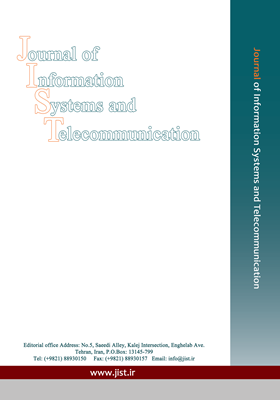A Bio-Inspired Self-configuring Observer/ Controller for Organic Computing Systems
Subject Areas :Ali Tarihi 1 , Hassan Haghighi 2 * , Fereidoon Shams Aliee 3
1 - Department of Computer Engineering and Science, Shahid Beheshti University, Tehran, Iran
2 - Department of Computer Engineering and Science, Shahid Beheshti University, Tehran, Iran
3 - Department of Computer Engineering and Science, Shahid Beheshti University, Tehran, Iran
Keywords: Organic Computing , Observer/ Controller Architecture , Self-Properties , Self-Configuration , Formal Verification,
Abstract :
The increase in the complexity of computer systems has led to a vision of systems that can react and adapt to changes. Organic computing is a bio-inspired computing paradigm that applies ideas from nature as solutions to such concerns. This bio-inspiration leads to the emergence of life-like properties, called self-* in general which suits them well for pervasive computing. Achievement of these properties in organic computing systems is closely related to a proposed general feedback architecture, called the observer/controller architecture, which supports the mentioned properties through interacting with the system components and keeping their behavior under control. As one of these properties, self-configuration is desirable in the application of organic computing systems as it enables by enabling the adaptation to environmental changes. However, the adaptation in the level of architecture itself has not yet been studied in the literature of organic computing systems. This limits the achievable level of adaptation. In this paper, a self-configuring observer/controller architecture is presented that takes the self-configuration to the architecture level. It enables the system to choose the proper architecture from a variety of possible observer/controller variants available for a specific environment. The validity of the proposed architecture is formally demonstrated. We also show the applicability of this architecture through a known case study.
[1] J. O. Kephart and D. M. Chess, “The vision of autonomic computing,” Computer, vol. 36, no. 1, pp. 41–50, 2003.#
[2] C. M&252;ller-Schloer, H. Schmeck, and T. Ungerer, Eds., Organic Computing - A Paradigm Shift for Complex Systems. Springer, 2011.#
[3] U. Richter, M. Mnif, J. Branke, C. M&252;ller-Schloer, and H. Schmeck, “Towards a generic observer/controller architecture for Organic Computing.,” GI Jahrestag. 1, vol. 93, pp. 112–119, 2006.#
[4] A. Berns and S. Ghosh, “Dissecting self- properties,” in Self-Adaptive and Self-Organizing Systems, 2009. SASO’09. Third IEEE International Conference on, 2009, pp. 10–19.#
[5] B. Satzger, A. Pietzowski, W. Trumler, and T. Ungerer, “Using automated planning for trusted self-organising organic computing systems,” in Autonomic and Trusted Computing, Springer, 2008, pp. 60–72.#
[6] H. Seebach, F. Nafz, J.-P. Stegh&246;fer, and W. Reif, “How to Design and Implement Self-organising Resource-Flow Systems,” in Organic Computing—A Paradigm Shift for Complex Systems, Springer, 2011, pp. 145–161.#
[7] M. Salehie and L. Tahvildari, “Self-adaptive software: Landscape and research challenges.,” TAAS, vol. 4, no. 2, Jul. 2009.#
[8] H. Schmeck, C. M&252;ller-Schloer, E. &199;akar, M. Mnif, and U. Richter, “Adaptivity and self-organization in organic computing systems,” ACM Trans Auton Adapt Syst, vol. 5, no. 3, pp. 10:1–10:32, Sep. 2010.#
[9] B. Alberts, D. Bray, J. Lewis, M. Raff, K. Roberts, and J. D. Watson, Molecular Biology of the Cell, 4th ed. Garland, 2002.#
[10] K. Kang, S. Cohen, J. Hess, W. Novak, and S. Peterson, “Feature-Oriented Domain Analysis (FODA) Feasibility Study,” Software Engineering Institute, Carnegie Mellon University, CMU/SEI-90-TR-21, 1990.#
[11] M. Riebisch, “Towards a more precise definition of feature models,” Model. Var. Object-Oriented Prod. Lines, pp. 64–76, 2003.#
[12] K. Lee and K. C. Kang, “Feature dependency analysis for product line component design,” in Software Reuse: Methods, Techniques, and Tools, Springer, 2004, pp. 69–85.#
[13] U. Brinkschulte, M. Pacher, and A. Von Renteln, “Towards an artificial hormone system for self-organizing real-time task allocation,” in Software Technologies for Embedded and Ubiquitous Systems, Springer, 2007, pp. 339–347.#
[14] M. Roth, J. Schmitt, R. Kiefhaber, F. Kluge, and T. Ungerer, “Organic Computing Middleware for Ubiquitous Environments.,” in Organic Computing, C. M&252;ller-Schloer, H. Schmeck, and T. Ungerer, Eds. Springer, 2011, pp. 339–351.#
[15] W. Brockmann, E. Maehle, K.-E. Grosspietsch, N. Rosemann, and B. Jakimovski, “ORCA: An organic robot control architecture,” in Organic Computing—A Paradigm Shift for Complex Systems, Springer, 2011, pp. 385–398.#
[16] F. Nafz, J.-P. Stegh&246;fer, H. Seebach, and W. Reif, “Formal modeling and verification of self-* systems based on observer/controller-architectures,” in Assurances for Self-Adaptive Systems, Springer, 2013, pp. 80–111.#
[17] V. C. Barbosa, An introduction to distributed algorithms. MIT Press, 1996.#
[18] M. Clavel, F. Dur’an, S. Eker, P. Lincoln, N. M. Oliet, J. Meseguer, and C. Talcott, All About Maude - A High-Performance Logical Framework: How to Specify, Program, and Verify Systems in Rewriting Logic. Springer, 2007.#

